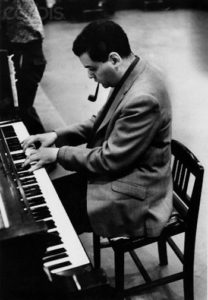David Kenneth Ritz Van Ronk (June 30, 1936 – February 10, 2002) was an American folk singer. An important figure in the American folk music revival and New York City's Greenwich Village scene in the 1960s, he was nicknamed the "Mayor of MacDougal Street".
Guitarist, singer, songwriter, and native New Yorker Dave Van Ronk inspired, aided, and promoted the careers of numerous singer/songwriters who came up in the blues tradition. Most notable of the many musicians he helped over the years was Bob Dylan, whom Van Ronk got to know shortly after Dylan moved to New York in 1961 to pursue a life as a folk/blues singer. Van Ronk's recorded output was healthy, but he was never as prolific a songwriter as some of his friends from that era, like Dylan or Tom Paxton. Instead, Van Ronk's genius was derived from his flawless execution and rearranging of classic acoustic blues tunes.
Van Ronk was born in Brooklyn, New York City, to a family that was "mostly Irish, despite the Dutch 'Van' name". He moved from Brooklyn to Queens around 1945 and began attending Holy Child Jesus Catholic School, whose students were mainly of Irish descent . He acquired a ukulele at 12 years old, a guitar a year later, and then he learned the banjo. His initial love was jazz, favoring singers like Bessie Smith, Billie Holiday, Jelly Roll Morton . He had been performing in a barbershop quartet since 1949, but left before finishing high school spending time in the Merchant Marine after which he left home for Greenwich Village, a few miles away.
Here’s “House Carpenter” from above LP
He took his inspiration from blues and folk singer Odetta, who encouraged him to play the classic jazz music that he was so keenly interested in. Often regarded as the grand uncle of the Greenwich Village coffeehouse scene, the self-effacing Van Ronk, an engaging intellectual and voracious reader, would have been the first to tell you that there were others, like Odetta, who were around the Village before him. As the blues and folk boom bloomed into the '60s, Van Ronk became part of an inner circle of musicians who lived in the Village, including then up-and-coming performers like Dylan, Paxton, Phil Ochs, Ramblin' Jack Elliot, and Joni Mitchell. An expert fingerpicker, Van Ronk was influenced as a vocalist by Bing Crosby and Louis Armstrong.
Van Ronk's recording career began in 1959 with Sings Ballads, Blues & a Spiritual on Moses Asch's Folkways label. His reputation wasn't solid, however, until he began recording for the Prestige label in the first half of the '60s. A collection of jazz tunes, In the Tradition, followed in 1964, and then Inside Dave Van Ronk. He switched to Mercury for two albums, one with the Ragtime Jug Stompers. These recordings allowed him to tour throughout the U.S. and perform at major folk festivals like Newport. Although he had a short-lived folk rock band called the Hudson Dusters in 1968, the bulk of Van Ronk's recordings were solo acoustic affairs.
Van Ronk was among 13 people arrested at the Stonewall Inn June 28, 1969, the night of the Stonewall Riots, which is widely credited as the spark of the contemporary gay rights movement. He had been dining at a neighboring restaurant and joined the riot against the police occupation of the club and was dragged from the crowd into the building by police deputy inspector Seymour Pine. The police slapped and punched Van Ronk to the point of near unconsciousness, handcuffed him to a radiator near the doorway, and charged him with assault.
Recalling the expanding riot, Van Ronk said, "There were more people outside the building when I came out than when I went in. Things were still flying through the air, cacophony—I mean, just screaming and yelling, sirens, strobe lights, the whole spaghetti."The next day, he was arrested and later released on his own recognizance for having thrown a heavy object at a police officer. City records show he was charged with felony assault in the second degree and pleaded guilty to the lesser charge of harassment.
During 1985 Van Ronk released his first all-original album, Going Back to Brooklyn, containing only his own songs. He continued to record throughout the '90s and beyond, with the Alcazar Records label releasing Another Time and Place in 1995 and Justin Time issuing Sweet and Lowdown in 2001.On February 10, 2002, Van Ronk died in a New York hospital of cardiopulmonary failure while undergoing ostoperative treatment for colon cancer. He died before completing work on his memoirs, which were finished by his collaborator, Elijah Wald, and published in 2005 as The Mayor Of MacDougal Street. Married to Terri Van Ronk in the 1960s, lived for many years with Joanne Grace, then married Andrea Vuocolo, with whom he spent the rest of his life.
(Edited from Wikipedia, Folkways & AllMusic)


























































